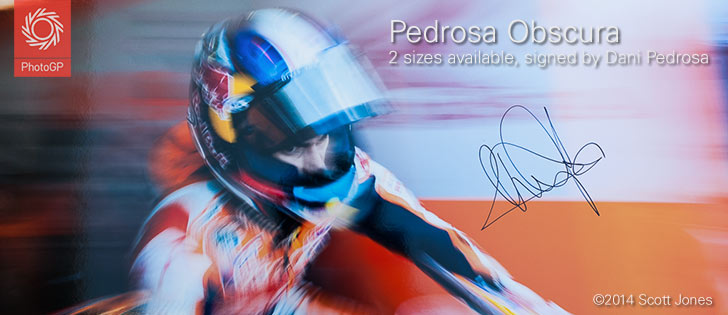Interview: Jordi Perez of IRTA
SJ: How do the inspectors know which engine is in which bike?
JP: We know which bike is which and we have a mark on each engine in a place that we can always see, even with the fairing on and everything. From the outside I can easily see which engine it is. And the team cannot remove the mark, they cannot change the mark, it is a very strong mark. The numbers [on the mark] are the factory identification and the engine identification.

When the team arrives [at a circuit] for the general technical inspection, it’s compulsory that they tell me “This is bike #1, this is bike #2,” and we put a mark on each chassis. When the inspectors arrive at the track and get to their assigned box, they identify which chassis is which and verify all the numbers for chassis and engines. They do this at the start of each session, they always reconfirm that the numbers are right.
Every day I receive all the information electronically, and this is the most important. The inspectors’ work is just a double check. For example, someone might say that another team changed a transponder and that we don’t know which engine they used, maybe they used a new engine. If the electronic system says they only used bike #2 and another team says, “No, we don’t agree,” we have the marshals from the FIM in each garage to certify which bike had which engine. So it’s really difficult for [the teams] to lie.
Everyone is asking about what happened with Marquez’ engine in Texas. [Note: at CotA in Qualifying 2 Marquez had his #2 engine fail, and while it is still not listed as Withdrawn From Allocation on the official sheet, it has not been used since.] Nothing happened. Honda can use five engines. And it’s not compulsory that Honda says to me that an engine is broken. I have to remove the seals, and I have to do this before the Monday after the final race at Valencia. That doesn’t mean that Honda has to tell me now that the engine is broken. They don’t need to tell me. I’ve sealed the engine, they cannot run it in a dyno, they cannot run it at another circuit, but they could use it at an official test to know if the engine is good or not. I know if they use it or not because if they want to I have to remove the seal, and then seal it again. But I’m not authorized to say what happens at a test. That’s not my job. My job is to say to you, to journalists or whoever asks, if anyone is cheating or not.

SJ: It does sound difficult to cheat with the electronic system and the inspectors there as a double check.
JP: They are actually triple check! Because the team has to tell me which engine is in which bike, one. If the engine is not new, if it has been used before, not only do they have to tell me which will be used but they have to call me to come over because I’m the one who will remove the seal I put on after the race. As soon as an engine is in the system, I control whether it can run or not. They can’t decide what they will do with the engines, because the rules are clear. Once in the system, the engines can be run only at the track for official practice and for races, not on a dyno, not for priivate practice. There are some exceptions for the Open class, but always they have to tell me.
SJ: So you track engine use at official tests as well?
JP: Yes, for example here [at Mugello] tomorrow is an official Michelin test with the factory and other riders. On that day they can use the engines in the system. Obviously factory riders use test engines because then they put less mileage on their five engines. But the Open teams, Pramac if they ride, Open class Honda, everyone else can use engines in the system, they don’t have test engines, too expensive.
SJ: Factory teams get five engines per rider with no engine development . Do you seal all five engines at the beginning of the season?
JP: No. At Losail we receive a minimum of three engines. Two they will use over the weekend. One we will keep as a reference, rather than a technical drawing.
It’s like what happened in Superbike. It doesn’t happen anymore, because I developed a system with Scott Smart, the Superbike Technical Director. Superbike chassis have to be standard. But what happened before, you could read it in the papers, saying Aprilia, or Suzuki, or Kawasaki, are using a new chassis and it’s much better. If they have a new chassis they don’t call the [public] customers saying “We have a new chassis and we’re going to exchange it for you because it’s much better!” No, the teams changes the chassis every single race when the chassis were supposed to be standard. But the constructors supply drawings, and the tolerances were plus or minus two meters! [We both laugh.] And then when you make the measurement of the chassis, it’s with the tolerances.
So I said to Scott, “I have an idea.”
He says, “Which one?”
“We put the same sticker that we put on the engines on the chassis. These stickers cost 14 euros each, are resistance to 300 degrees C, resist petrol, any cleaner, it’s the same as are used on planes, on Rolls Royce jet engines, but more developed that we have done with the only company in the world who makes these, it’s a fantastic product. Ok, so we put a sticker on the chassis, and when they want to change the chassis, they have to bring in the new one, and they say, “Ok, we have to change because we had a crash.” So you put the old and the new together and they have to be the same, plus or minus almost nothing. Then it’s very easy to see if it’s standard or not.
So that’s the same thing we do with the MotoGP engines. Of course it’s not as easy. We have to open some engines, for example every time Moto3 has a new spec, we keep one of each factory and so far we haven’t found anything. But MotoGP is more complicated than Moto3.
And of course it’s very important to ensure that in our championship no one is cheating. So we have that one engine of each from the start of the season. And if we need to we open it and we can check anything. Every race it’s Danny Aldridge, the Technical Director, who decides if we check something. He’s in charge of the technical things, I’m just his helper and his hands for this.
For example, I always know the mileage of the engines. It’s very easy with this systems. I know how many laps each engine does via the transponder, and I know the lap distance. So If I know an engine has a life of 2,000 kilometers, but an engine has 2,200, I go quickly to the engine to check. I check everything! But I check with particular interest to make sure that they aren’t cheating. We have many systems for this.
Our thanks to Mr. Perez for taking time to explain his system to us.
Photographs: ©2015 by Scott Jones / PHOTO.GP – All Rights Reserved










Please sign in or register to contribute a comment or question.